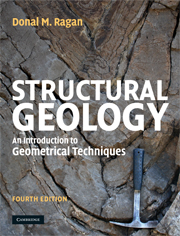Book contents
- Frontmatter
- Contents
- Preface
- Acknowledgements
- 1 Structural planes
- 2 Thickness and depth
- 3 Lines and intersecting planes
- 4 Planes and topography
- 5 Stereographic projection
- 6 Rotations
- 7 Vectors
- 8 Faults
- 9 Stress
- 10 Faulting
- 11 Deformation
- 12 Strain
- 13 Flow
- 14 Folds
- 15 Parallel folds
- 16 Similar folds
- 17 Folds and topography
- 18 Structural analysis
- 19 Tectonites
- 20 Drill hole data
- 21 Maps and cross sections
- 22 Block diagrams
- Appendices
- References
- Index
16 - Similar folds
Published online by Cambridge University Press: 05 June 2012
- Frontmatter
- Contents
- Preface
- Acknowledgements
- 1 Structural planes
- 2 Thickness and depth
- 3 Lines and intersecting planes
- 4 Planes and topography
- 5 Stereographic projection
- 6 Rotations
- 7 Vectors
- 8 Faults
- 9 Stress
- 10 Faulting
- 11 Deformation
- 12 Strain
- 13 Flow
- 14 Folds
- 15 Parallel folds
- 16 Similar folds
- 17 Folds and topography
- 18 Structural analysis
- 19 Tectonites
- 20 Drill hole data
- 21 Maps and cross sections
- 22 Block diagrams
- Appendices
- References
- Index
Summary
Introduction
Several mechanisms for producing similar folds have been proposed (Ramsay, 1967, p. 43; Bayly, 1971; Matthews, et al., 1971). The simplest of these can be illustrated with a deck of cards. A layer is represented by a band drawn on the edge of a deck which is then deformed by inhomogeneous simple shear.
This is called shear folding. Because each individual card and the portion of the band marked on its edge remain undistorted during displacement the thickness of the band measured parallel to the shear plane is constant. This is also the axial-plane direction, hence the folded layer has constant axial-plane thickness and parallel isogons, and this is the distinguishing characteristic of Class 2 folds.
In this model folding the band on the edge of the cards plays no mechanical role – it simply reflects the pattern of inhomogeneous shear. This behavior is passive. Similarly in nature, a layer subject to shear folding can act only as a passive marker. It can not have mechanical properties which differ significantly from the surrounding material, for if it did there would be a component of bending or buckling and the resulting folds would not be ideally similar. Because rock bodies are commonly composed of contrasting lithologies similar folds are rare. However, they might be expected in rocks which are monomineralic or nearly so.
- Type
- Chapter
- Information
- Structural GeologyAn Introduction to Geometrical Techniques, pp. 441 - 453Publisher: Cambridge University PressPrint publication year: 2009



